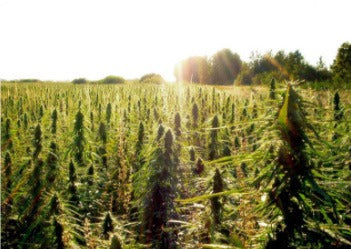Does CBD Make You High?

It’s best to go through life with a “never say never” mentality. So, whatever’s the next best thing to “never” is your answer to “does CBD make you high?” The way our system reacts to cannabidiol (CBD), a predominant molecule found in hemp, is completely different compared to how it responds to tetrahydrocannabinol (THC), the primary compound in marijuana. Understanding these differences is not only essential for living a healthy lifestyle, but for the legality of cannabis. Let’s discuss why CBD doesn’t get you high and how to get all the benefits of CBD without consuming THC.
What Is CBD And THC?
To understand why CBD doesn’t elicit psychoactive effects, let’s first discuss its relationship to THC. Both of these compounds are types of phytocannabinoids. Phytocannabinoids are plant-based molecules that are found in plants in the cannabis family.
It’s true that black truffles contain one of our body’s natural endocannabinoids, anandamide, and that echinacea has cannabinoid-like molecules. In the plant world, however, cannabis plants have a majority stake in cannabinoids.
There are over 100 phytocannabinoids found in cannabis plants. Thousands of different molecules make up a single cannabis plant. For instance, hemp has aromatic molecules (known as terpenes) including linalool and humulene. Hemp also contains all 21 amino acids and various other nutrients.
Each of these molecules plays a role in the growth of hemp plants. Consequently, each has its own interaction with the human body. Let’s take a closer look at the differences.
Why Do CBD And THC React Differently?
Think about a delicious piece of garlic bread coming straight out of the oven. Now, imagine the nuances of taking your first bite into this guilty pleasure. This isn’t an attempt to make you hungry; it’s supposed to help draw parallels (though an increased appetite might be a welcomed side effect).
Garlic smells pungent but tastes oh-so delicious, plus it’s excellent for the heart. The buttery spread on the bread can be beneficial in moderation (hello, Bulletproof coffee!), while too much butter can cause our cholesterol to go through the roof. There’s also gluten in the bread. Gluten is one of the top dietary allergens in the world. If you add in some cheese to melt on top, you’re adding in the other top dietary allergen: lactose.
Looking at all the pros and cons of garlic bread is a real roller coaster of emotions. Each ingredient has a unique interaction with our body. When we add or subtract certain ingredients, the flavor and our body’s response changes entirely. Understanding these differences will make it easier to comprehend how CBD and THC can both exist in cannabis but cause two different experiences.
CBD, THC, And The Endocannabinoid System
The popularity of CBD products has skyrocketed due to the way that phytocannabinoids interact with our endocannabinoid system. Our endocannabinoid system is like our internal checks-and-balances organization. This well-run system is regulated by microscopic communicators known as cannabinoid receptors.
There are countless cannabinoid receptors throughout our body. These are alarm systems that are adhered to our cells. Whenever the natural balance is off in the area they’re patrolling, these receptors will report back to the system.
In the most accurate game of telephone ever, this message will follow up the chain of command until it reaches the central nervous system. Here, the brain interprets the information and voila! The message manifests as the discomfort or agitation we sometimes experience.
Whenever we face this adversity, our body gets to work to remedy the situation. The first line of defense is to produce our body’s natural endocannabinoids. Endocannabinoids stimulate and bind to the distressed receptors. This interaction promotes a balancing effect throughout the endocannabinoid system.
Unfortunately, we run into many roadblocks on a daily basis. These bumps in the road range from viruses to work-related stress to underlying health issues. Whatever the case may be, the burden can be heavy on our natural endocannabinoids.
Thankfully, our body can enjoy many of the same benefits from plant-based cannabinoids. Much like garlic bread’s individual ingredients interact with us uniquely, so do the phytocannabinoids in cannabis.
Differences Between CBD And THC
THC is the cannabinoid found in cannabis that’s responsible for psychoactive effects. It’s the active ingredient that causes a “high” in marijuana users. These mind-altering effects are due to the molecular structure of this phytocannabinoid and how these chemical properties interact with our cannabinoid receptors.
CBD and THC are very similar on a molecular level. They each contain:
- 30 hydrogen atoms.
- 21 carbon atoms.
- 2 oxygen atoms.
What makes them vastly different comes down to the placement of one hydrogen atom. This seemingly insignificant difference allows THC to bind to our cannabinoid receptors, whereas CBD only stimulates them. While that might sound minuscule, this one atom makes a monumental difference.
Which Cannabinoid Receptors Work With CBD vs. THC?
Our endocannabinoid system is all about polarity. There needs to be balance. To ensure this, our bodies have two sets of cannabinoid receptors. Each set of receptors govern particular areas.
Our cannabinoid receptors are:
- CB1 (situated in the brain, organs, tissues, and glands).
- CB2 (situated in the immune cells, spleen, bones, and gut).
The difference in molecular structure comes into play here because THC can bind to CB1 receptors, while CBD cannot. CB1 receptors have a significant influence on the central nervous system, which is how THC causes the psychoactive experience associated with smoking marijuana.
CBD has a weak affinity to receptors. Instead, this phytocannabinoid oversees operations. It can, however, stimulate CB1 or CB2 receptors to influence a change. When this happens, CBD may alter the way receptors interact with other cannabinoids.
Additionally, CBD can help preserve our natural endocannabinoids. Endocannabinoids get burned off by enzymes in our system, namely fatty acid amide hydrolase (FAAH) and monoacylglycerol lipase (MAGL). CBD slows the process of the enzymes destroying these pivotal regulators to help offer the support our body needs to remain balanced.
Why Can’t CBD Cause A High?
To understand this phenomenon, let’s talk about why THC makes you high in the first place. When THC seeks out CB1 receptors in the brain, it triggers a part of the body that is known as the extracellular signal-regulated kinase (ERK) pathway.
The ERK pathway is situated in our hippocampus. This area of our brain plays a significant role in memory and cognition. When THC binds to CB1 receptors, the ERK pathway becomes overstimulated. In turn, it creates the distorted reality that we perceive as a high.
While CBD can stimulate CB1 receptors, it does not bind to it. Therefore, it does not overstimulate the ERK pathway and cause perceptual distortion.
Will CBD Oil With 0.3% THC Get Me High?
The presence of trace amounts of THC shouldn’t set off any red flags for most people.
Before 2018, hemp wasn’t federally legal. Once we discovered the chemical variations of THC and CBD, the government acknowledged that there are differences between hemp and marijuana. Under federal law, the government mandated that all agricultural hemp may contain 0.3% THC or less. This negligible amount shouldn't be enough to produce a euphoric feeling, but it’s enough to promote some of the potential positive effects of THC.
With that said, states that have recreational and medical cannabis programs might use marijuana to create their CBD or breed hemp to have high levels of THC. These sorts of products may indeed cause a high due to the presence of THC, so be sure to thoroughly read the labels of any CBD products before you make a purchase.
How To Get 0.0% THC CBD Oil
As a family-owned and operated business, we understand why you wouldn’t want to give your loved ones a product with THC in it. That’s why all of our products are 0.0% THC.
We go the extra mile to preserve the integrity of the phytocannabinoids found in the whole hemp plant. After we isolate the cannabinoids (and denote them in our lab reports), we remove any traces of THC.
Hemp already has only 0.3% THC or less, so your body won’t miss out on the potential benefits of this phytocannabinoid. In fact, you have many other phytocannabinoids present to make up for the lack of THC, so you still experience the entourage effect. Our cutting-edge technology and proprietary hemp plants make Joy Organics the premier full and broad-spectrum hemp extract on the market.
Have any questions or concerns about getting high from CBD oil? Share your worries with us in the comments so we can address them for the entire community!
Thanks for reading! To show how much we appreciate you, we’re going to give you 16% off your next order. Just use code READER16 at checkout!

Medically reviewed by
Kimberly Langdon, M.D.
Newsletter signup
Join the Joy Organics Family
Sign up and get updates on new products, as well as special coupons and discounts.
testimonials
What Our Clients Say
“This is a company that truly cares about its customers and providing the best CBD products currently available on the market.”










Join In On The Conversation
Your email address will not be published. Required fields are marked *
Comments will be approved before showing up.